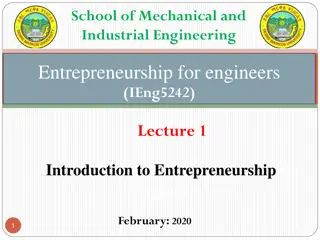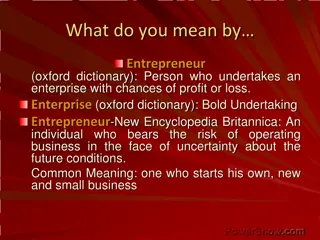Managing Finances and Raising Capital in Entrepreneurship
Learn about managing finances, raising capital, and key concepts like LTV (Lifetime Value of a Customer) and COCA (Cost of Customer Acquisition) in the context of entrepreneurship. Explore the Entrepreneurship Paradigm and understand the importance of identifying markets, building prototypes, and scaling a business. Dive into the calculation of LTV and its key inputs to assess customer profitability.
Uploaded on Apr 13, 2025 | 0 Views
Download Presentation

Please find below an Image/Link to download the presentation.
The content on the website is provided AS IS for your information and personal use only. It may not be sold, licensed, or shared on other websites without obtaining consent from the author.If you encounter any issues during the download, it is possible that the publisher has removed the file from their server.
You are allowed to download the files provided on this website for personal or commercial use, subject to the condition that they are used lawfully. All files are the property of their respective owners.
The content on the website is provided AS IS for your information and personal use only. It may not be sold, licensed, or shared on other websites without obtaining consent from the author.
E N D
Presentation Transcript
Entrepreneurship for Computer Science Entrepreneurship for Computer Science CS 15-390 How to Manage Your Finances and Raise Capital? Part II Lecture 12, November 06, 2023 Mohammad Hammoud
Today Last Lecture: How to manage your finances and raise capital? Part I Today s Lecture: How to manage your finances and raise capital? Part II Unit Economics: LTV and COCA Announcements: Project report 4 is due today by midnight Send me by Nov 8 an email about your progress in developing your prototype Quiz III is on November 13 Prototypes are due on November 20
Entrepreneurship Paradigm A System of Functions Paradigm: Functions Identify & Research a Market Found or Co-found a Company Build a Business Model Identify a Problem Build a Prototype Bootstrap and/or Raise Angle Fund Raise Market & Operate Build a Culture Build an MVP Professional Money Scale Exit
Entrepreneurship Paradigm A System of Functions Paradigm: Functions Identify & Research a Market Found or Co-found a Company Build a Business Model Identify a Problem Build a Prototype Bootstrap and/or Raise Angle Fund Raise Market & Operate Build a Culture Build an MVP Professional Money Scale Exit
Overview Unit Economics LTV COCA
What is LTV and Why? Lifetime Value of an Acquired Customer (LTV) is a measure of the average gross profit your business expects to make from a typical customer For as long as that person remains a customer (thus, it extends to the future) It can be defined as the present value of the future cash flows from a typical customer during their entire relationship with your company It boils down to a single number that can be compared against COCA for estimating your average customer s profitability
Key Inputs to Calculate LTV 1. Revenue Streams This depends on your business model (whether it is transactional, recurrent, usage-based, or a mix) 2. Gross Margin (for each of your revenue streams) Gross margin = price direct cost 3. Retention Rate This is the percentage of customers who will continue to pay for your product
Key Inputs to Calculate LTV 4. Life of Product This is the duration you expect your product will last before the customer either discontinues using it or purchases a replacement 5. Next Product Purchase Rate This is the percentage of customers who will buy a replacement product from you when the life of the current product ends 6. Cost of Capital Rate (or Discount Rate) For a new entrepreneur who lacks a track record, an appropriate number is between 35% and 75% (also, the riskier your venture is, the higher the rate)
How to Calculate LTV? Algorithm: 1. for each year y 2. for each revenue stream in your business model 3. if in year y the customer will replace your product 4. use gross margin , retention rate , and 5. next product purchase rate to calculate your profit p 6. else 7. use gross margin and retention rate 8. to calculate your profit p 9. total_profit += p 10. calculate the present value, Pv,of total_profit in y 11. LTV += Pv 12. total_profit = 0
Example: Widget Assume a conceptual case study of a company that makes a widget Widget s business model involves a one-time, up-front charge for the widget, alongside an annual recurring fee for maintenance One-time Revenue One-time Revenue One-time Revenue One-time Revenue One-time Revenue One-time Revenue Recurring Maintenance Revenue Recurring Maintenance Revenue Recurring Maintenance Revenue Recurring Maintenance Revenue Recurring Maintenance Revenue Recurring Maintenance Revenue $10,000 $10,000 $10,000 $10,000 $10,000 $10,000 15% of the up-front charge after a 6-month warranty period warranty period warranty period warranty period warranty period warranty period 15% of the up-front charge after a 6-month 15% of the up-front charge after a 6-month 15% of the up-front charge after a 6-month 15% of the up-front charge after a 6-month 15% of the up-front charge after a 6-month Widget Price Widget Price Widget Price Widget Price Widget Price Widget Price 65% 65% 65% 65% 65% 65% 85% 85% 85% 85% 85% 85% Gross Margin Gross Margin Gross Margin Gross Margin Gross Margin Gross Margin 100% in year 0 and 90% in subsequent years 100% in year 0 and 90% in subsequent years 100% in year 0 and 90% in subsequent years 100% in year 0 and 90% in subsequent years 100% in year 0 and 90% in subsequent years 100% in year 0 and 90% in subsequent years Retention Rate Retention Rate Retention Rate Retention Rate Retention Rate Retention Rate 5 years 5 years 5 years 5 years 5 years 5 years 5 years 5 years 5 years 5 years 5 years 5 years Life of Product Life of Product Life of Product Life of Product Life of Product Life of Product 75% 75% 75% 75% 75% 75% 75% 75% 75% 75% 75% 75% Next Product Purchase Rate Next Product Purchase Rate Next Product Purchase Rate Next Product Purchase Rate Next Product Purchase Rate Next Product Purchase Rate 50% 50% 50% 50% 50% 50% 50% 50% 50% 50% 50% 50% Cost of Capital Rate Cost of Capital Rate Cost of Capital Rate Cost of Capital Rate Cost of Capital Rate Cost of Capital Rate
Calculating LTV for Widget Revenue Stream 1: One-time, up-front payment for a widget How much grossprofit can be made of this channel? Year 0 Year 0 Year 0 Year 0 Year 1 Year 1 Year 1 Year 1 Year 2 Year 2 Year 2 Year 2 Year 3 Year 3 Year 3 Year 3 Year 4 Year 4 Year 4 Year 4 Year 5 Year 5 Year 5 Year 5 Price of a Widget Price of a Widget Price of a Widget Price of a Widget $10,000 $10,000 $10,000 $10,000 $10,000 $10,000 $10,000 $10,000 Next Product Purchase Rate Purchase Rate Purchase Rate Purchase Rate Next Product Next Product Next Product 0.75 0.75 0.75 0.75 Gross Margin of a Widget a Widget a Widget a Widget Gross Margin of Gross Margin of Gross Margin of 0.65 0.65 0.65 0.65 0.65 0.65 0.65 0.65 Profit from a Widget Widget Widget Widget Profit from a Profit from a Profit from a (10,000 0.65) = $6,500 = $6,500 = $6,500 = $6,500 (10,000 0.65) (10,000 0.65) (10,000 0.65) (10,000 0.75 0.65) = $4,875 = $4,875 = $4,875 = $4,875 (10,000 0.75 0.65) (10,000 0.75 0.65) (10,000 0.75 0.65)
Calculating LTV for Widget Revenue Stream 2: Maintenance for a widget How much grossprofit can be made of this channel? Year 0 Year 0 Year 0 Year 0 Year 0 Year 0 Year 1 Year 1 Year 1 Year 1 Year 1 Year 1 Year 2 Year 2 Year 2 Year 2 Year 2 Year 2 Year 3 Year 3 Year 3 Year 3 Year 3 Year 3 Year 4 Year 4 Year 4 Year 4 Year 4 Year 4 Year 5 Year 5 Year 5 Year 5 Year 5 Year 5 Cost of Maintenance Cost of Maintenance Cost of Maintenance Cost of Maintenance Cost of Maintenance Cost of Maintenance $750 $750 $750 $750 $750 $750 $1500 $1500 $1500 $1500 $1500 $1500 $1500 $1500 $1500 $1500 $1500 $1500 $1500 $1500 $1500 $1500 $1500 $1500 $1500 $1500 $1500 $1500 $1500 $1500 $750 $750 $750 $750 $750 $750 Retention Rate (say, r) Retention Rate (say, r) Retention Rate (say, r) Retention Rate (say, r) Retention Rate (say, r) Retention Rate (say, r) 1 1 1 1 1 1 0.9 0.9 0.9 0.9 0.9 0.9 0.9 0.9 0.9 0.9 0.9 0.9 0.9 0.9 0.9 0.9 0.9 0.9 0.9 0.9 0.9 0.9 0.9 0.9 Cumulative r (= ry, where y Cumulative r (= ry, where y Cumulative r (= ry, where y Cumulative r (= ry, where y Cumulative r (= ry, where y (0.91) = 0.9 (0.91) = 0.9 (0.91) = 0.9 (0.91) = 0.9 (0.91) = 0.9 (0.91) = 0.9 (0.92) = 0.81 (0.92) = 0.81 (0.92) = 0.81 (0.92) = 0.81 (0.92) = 0.81 (0.92) = 0.81 (0.93) = 0.729 (0.93) = 0.729 (0.93) = 0.729 (0.93) = 0.729 (0.93) = 0.729 (0.93) = 0.729 (0.94) = 0.656 (0.94) = 0.656 (0.94) = 0.656 (0.94) = 0.656 (0.94) = 0.656 (0.94) = 0.656 Cumulative r (= ry, where y = no of years after year 0) = no of years after year 0) = # of years after year 0) = # of years after year 0) = # of years after year 0) = # of years after year 0) 1 1 1 1 1 1 0.656 0.656 0.656 0.656 0.656 0.656 Next Product Purchase Next Product Purchase Next Product Purchase Next Product Purchase Next Product Purchase 0.75 0.75 0.75 0.75 0.75 0.75 Next Product Purchase Rate Rate Rate Rate Rate Rate Gross Margin of Gross Margin of Gross Margin of Gross Margin of Gross Margin of 0.85 0.85 0.85 0.85 0.85 0.85 0.85 0.85 0.85 0.85 0.85 0.85 0.85 0.85 0.85 0.85 0.85 0.85 0.85 0.85 0.85 0.85 0.85 0.85 0.85 0.85 0.85 0.85 0.85 0.85 0.85 0.85 0.85 0.85 0.85 0.85 Gross Margin of Maintenance Maintenance Maintenance Maintenance Maintenance Maintenance Profit from Maintenance Profit from Maintenance Profit from Maintenance Profit from Maintenance Profit from Maintenance Profit from Maintenance (750 1 0. (750 1 0. (750 1 0. (750 1 0. (1500 0.9 (1500 0.9 (1500 0.9 (1500 0.9 (1500 0.81 (1500 0.81 (1500 0.81 (1500 0.81 (1500 0.729 (1500 0.729 (1500 0.729 (1500 0.729 (1500 0.656 (1500 0.656 (1500 0.656 (1500 0.656 = (750 0.656 = (750 0.656 = (750 0.656 = (750 0.656 (750 1 0. 85) = 85) = 85) = 85) = 85) = (750 1 0. 85) = $637.5 $637.5 $637.5 $637.5 $637.5 $637.5 (1500 0.9 0.85) = 0.85) = 0.85) = 0.85) = 0.85) = (1500 0.9 0.85) = $1,147.5 $1,147.5 $1,147.5 $1,147.5 $1,147.5 $1,147.5 (1500 0.81 0.85) = 0.85) = 0.85) = 0.85) = 0.85) = (1500 0.81 0.85) = $1,032.75 $1,032.75 $1,032.75 $1,032.75 $1,032.75 $1,032.75 (1500 0.729 0.85) = 0.85) = 0.85) = 0.85) = 0.85) = (1500 0.729 0.85) = $929.48 $929.48 $929.48 $929.48 $929.48 $929.48 (1500 0.656 0.85) = $836.40 $836.40 $836.40 $836.40 $836.40 $836.40 (1500 0.656 0.85) = 0.85) = 0.85) = 0.85) = 0.85) = = (750 0.656 0.75 0.85) = 0.75 0.85) = 0.75 0.85) = 0.75 0.85) = 0.75 0.85) = = (750 0.656 0.75 0.85) = $313.65 $313.65 $313.65 $313.65 $313.65 $313.65
Calculating LTV for Widget Lifetime Value of An Acquired Customer (LTV): Year 0 Year 0 Year 0 Year 0 Year 0 Year 0 Year 1 Year 1 Year 1 Year 1 Year 1 Year 1 Year 2 Year 2 Year 2 Year 2 Year 2 Year 2 Year 3 Year 3 Year 3 Year 3 Year 3 Year 3 Year 4 Year 4 Year 4 Year 4 Year 4 Year 4 Year 5 Year 5 Year 5 Year 5 Year 5 Year 5 $6,500 $6,500 $6,500 $6,500 $6,500 $6,500 $4,875 $4,875 $4,875 $4,875 $4,875 $4,875 Profit from a Profit from a Profit from a Profit from a Profit from a Profit from a Widget Widget Widget Widget Widget Widget $637.5 $637.5 $637.5 $637.5 $637.5 $637.5 $1,147.5 $1,147.5 $1,147.5 $1,147.5 $1,147.5 $1,147.5 $1,032.75 $1,032.75 $1,032.75 $1,032.75 $1,032.75 $1,032.75 $929.48 $929.48 $929.48 $929.48 $929.48 $929.48 $836.40 $836.40 $836.40 $836.40 $836.40 $836.40 $313.65 $313.65 $313.65 $313.65 $313.65 $313.65 Profit from Profit from Profit from Profit from Profit from Profit from Maintenance Maintenance Maintenance Maintenance Maintenance Maintenance $7,137.50 $7,137.50 $7,137.50 $7,137.50 $7,137.50 $7,137.50 $1,147.5 $1,147.5 $1,147.5 $1,147.5 $1,147.5 $1,147.5 $1,032.75 $1,032.75 $1,032.75 $1,032.75 $1,032.75 $1,032.75 $929.48 $929.48 $929.48 $929.48 $929.48 $929.48 $836.40 $836.40 $836.40 $836.40 $836.40 $836.40 $5,188.65 $5,188.65 $5,188.65 $5,188.65 $5,188.65 $5,188.65 Sum of Profits Sum of Profits Sums of Profits Sums of Profits Sums of Profits Sums of Profits 0.5 0.5 0.5 0.5 0.5 0.5 0.5 0.5 0.5 0.5 0.5 0.5 0.5 0.5 0.5 0.5 0.5 0.5 0.5 0.5 0.5 0.5 0.5 0.5 0.5 0.5 0.5 0.5 0.5 0.5 0.5 0.5 0.5 0.5 0.5 0.5 Cost of Capital Cost of Capital Cost of Capital Cost of Capital Cost of Capital Cost of Capital Rate Rate Rate Rate Rate Rate (7137/1.50) (7137/1.50) (7137/1.50) (7137/1.50) (7137/1.50) (1147.5/1.51) (1147.5/1.51) (1147.5/1.51) (1147.5/1.51) (1147.5/1.51) (1032.75/1.52) (1032.75/1.52) (1032.75/1.52) (1032.75/1.52) (1032.75/1.52) (929.48/1.53) (929.48/1.53) (929.48/1.53) (929.48/1.53) (929.48/1.53) (836.4/1.54) (836.4/1.54) (836.4/1.54) (836.4/1.54) (836.4/1.54) (5188.65/1.55) (5188.65/1.55) (5188.65/1.55) (5188.65/1.55) (5188.65/1.55) (7137/1.50) = $7,137 = $7,137 = $7,137 = $7,137 = $7,137 = $7,137 (1147.5/1.51) = $765 = $765 = $765 = $765 = $765 = $765 (1032.75/1.52) = $459 = $459 = $459 = $459 = $459 = $459 (929.48/1.53) = $275.4 = $275.4 = $275.4 = $275.4 = $275.4 = $275.4 (836.4/1.54) = $165.24 = $165.24 = $165.24 = $165.24 = $165.24 = $165.24 (5188.65/1.55) = $683.285 = $683.285 = $683.285 = $683.285 = $683.285 = $683.285 Present Values of Present Values of Present Values of Present Values of Present Values of Profits LTV LTV LTV LTV LTV LTV Present Values of Profits Profits Profits Profits Profits $9485.425 $9485.425 $9485.425 $9485.425 $9485.425 $9485.425
Important Considerations The business model is very critical Your choice of the business model can greatly impact your LTV Recurring income: Pros: Can increase revenue Cons: Might necessitate additional capital from investors up-front (especially, if there are no up-front charges); hence, potentially increasing the cost of capital One-time, up-front charge: Pros: Can reduce the amount of capital needed initially; hence, potentially decreasing the cost of capital Cons: Might not appeal to customers
Important Considerations LTV is about profit, not revenue A common mistake among entrepreneurs is to tally up revenue (not profits) out of the business model streams Gross margin and cost of capital rate are integral to determining an accurate LTV Gross margins make a big difference Try to wrap your potentially lower-margin core product with high-margin add-on products, services, or upselling opportunities (e.g., analytics reports, which might significantly appeal to customers!)
Important Considerations The retention rate is very critical as well A small increase in your retention rate leads to a significant improvement in your cumulative profit The overhead (or indirect) costs are not negligible To simplify LTV calculations, the overhead costs are excluded These costs might be high though! As such, LTV should be substantially greater than COCA
Summary LTV is the profit that a (just 1, hence, unit economics) new customer will provide on average, discounted to the present value It is important to be realistic, not optimistic, when calculating LTV Try to understand the underlying drivers behind LTV so you can work towards increasing it An LTV:COCA ratio of 3:1 or higher is what you shall aim for
Overview Unit Economics LTV COCA
Cost of Customer Acquisition (COCA) How much does it cost you to acquire a new customer? In other words, how much is your COCA? In calculating your COCA, you must quantify all the sales & marketing costs involved in acquiring a single average customer in steady state Salesmen salaries, admin support, travel, entertainment, trade shows, phone, Internet, social media ads, etc., are part of sales & marketing costs This necessitates that you understand your sales process very well! Production, R&D, finance and administrations, and any other overhead costs are not part of your sales & marketing costs
COCA vs. LTV For almost all new ventures, COCA will start very high and decrease over time (opposite to LTV) Point of Equilibrium (but with enough volume) LTV $ Cash-flow Negative Cash-flow Positive COCA Time
How to Calculate COCA? To calculate COCA, you need to account for 3 metrics: 1. Total Marketing and Sales Expense over Time or TMSE(t) 2. Install Base Support Expense over Time or IBSE(t) This is the cost to retain existing customers 3. New Customers over Time or NC(t) COCA = (TMSE(t) IBSE(t))/NC(t) COCA is typically calculated over 3 consecutive time periods, namely, short-term (e.g., 1st year of sales), medium-term (e.g., 2nd and 3rd years of sales), and long-term (e.g., 4th and 5th years of sales) periods Depending on your venture, these periods may vary!
Example: Associated Gas Energy Oil drilling typically produces associated gas , which is costly to deal with and problematic for the environment Assume a new venture, namely, Associated Gas Energy, with a GTL (Gas To Liquid) technology to convert associated gas into a crude oil A potential customer can be convinced to buy using old-fashioned direct sales methods, especially at the beginning
Example: Associated Gas Energy Year 1 Plan: Hire an experienced salesperson (say, full package at $175K/year) Hire a tech sales support person (say, full package at $125K/year) Hire a consultant to help break through the initial customer inertia and get all regulatory issues taken care of (say, full package at $150K/year) Spend on travel (say, $24K), develop ads material (say, $15K), conduct a trade show (say, $30K), and develop a website (say, $10K) Expected number of customers is 1
Example: Associated Gas Energy Years 2 & 3 Plans: Let go the consultant since all regulatory issues will be resolved by then, let alone that the hardest sale (i.e., the first sale) will be closed Hire one extra salesperson and another tech support person every year to increase sales Increase spending on travel, ads material, trade shows, and website maintenance (numbers will be shown in a subsequent table) Expected numbers of customers are 3 & 7 in years 2 & 3, respectively We will assume 3 time periods over only 3 years
Example: Associated Gas Energy COCA Calculation: TMSE Year 1 Year 1 Year 1 Year 1 Year 1 Year 1 Year 1 Year 1 Year 2 Year 2 Year 2 Year 2 Year 2 Year 2 Year 2 Year 2 Year 3 Year 3 Year 3 Year 3 Year 3 Year 3 Year 3 Year 3 Salespeople Salaries Salespeople Salaries Salespeople Salaries Salespeople Salaries Salespeople Salaries Salespeople Salaries Salespeople Salaries Salespeople Salaries $175K 1 = $175K $175K 1 = $175K $175K 1 = $175K $175K 1 = $175K $175K 1 = $175K $175K 1 = $175K $175K 1 = $175K $175K 1 = $175K $175K 2 = $350K $175K 2 = $350K $175K 2 = $350K $175K 2 = $350K $175K 2 = $350K $175K 2 = $350K $175K 2 = $350K $175K 2 = $350K $175K 3 = $525K $175K 3 = $525K $175K 3 = $525K $175K 3 = $525K $175K 3 = $525K $175K 3 = $525K $175K 3 = $525K $175K 3 = $525K Tech Support People Tech Support People Tech Support People Tech Support People Tech Support People Tech Support People Tech Support People Tech Support People Salaries Salaries Salaries Salaries Salaries Salaries Salaries Salaries $125 1 = $125K $125 1 = $125K $125 1 = $125K $125 1 = $125K $125 1 = $125K $125 1 = $125K $125 1 = $125K $125 1 = $125K $125 2 = $250K $125 2 = $250K $125 2 = $250K $125 2 = $250K $125 2 = $250K $125 2 = $250K $125 2 = $250K $125 2 = $250K $125 3 = $375K $125 3 = $375K $125 3 = $375K $125 3 = $375K $125 3 = $375K $125 3 = $375K $125 3 = $375K $125 3 = $375K Travel Travel Travel Travel Travel Travel Travel Travel $24,000 $24,000 $24,000 $24,000 $24,000 $24,000 $24,000 $24,000 $40,000 $40,000 $40,000 $40,000 $40,000 $40,000 $40,000 $40,000 $52,500 $52,500 $52,500 $52,500 $52,500 $52,500 $52,500 $52,500 Ad Material Ad Material Ad Material Ads Material Ads Material Ads Material Ads Material Ads Material $15,000 $15,000 $15,000 $15,000 $15,000 $15,000 $15,000 $15,000 $24,000 $24,000 $24,000 $24,000 $24,000 $24,000 $24,000 $24,000 $30,000 $30,000 $30,000 $30,000 $30,000 $30,000 $30,000 $30,000 Events Events Events Events Events Events Events Events $30,000 $30,000 $30,000 $30,000 $30,000 $30,000 $30,000 $30,000 $35,000 $35,000 $35,000 $35,000 $35,000 $35,000 $35,000 $35,000 $40,000 $40,000 $40,000 $40,000 $40,000 $40,000 $40,000 $40,000 Website Cost Website Cost Website Cost Website Cost Website Cost Website Cost Website Cost Website Cost $10,000 $10,000 $10,000 $10,000 $10,000 $10,000 $10,000 $10,000 $10,000 $10,000 $10,000 $10,000 $10,000 $10,000 $10,000 $10,000 $10,000 $10,000 $10,000 $10,000 $10,000 $10,000 $10,000 $10,000 Consultant Consultant Consultant Consultant Consultant Consultant Consultant Consultant $150,000 $150,000 $150,000 $150,000 $150,000 $150,000 $150,000 $150,000 $0 $0 $0 $0 $0 $0 $0 $0 $0 $0 $0 $0 $0 $0 $0 $0 TMSE TMSE TMSE TMSE TMSE TMSE TMSE TMSE TMSE(1) = $394,000 TMSE(1) = $394,000 TMSE(1) = $394,000 TMSE(1) = $394,000 TMSE(1) = $394,000 TMSE(1) = $394,000 TMSE(1) = $394,000 TMSE(1) = $394,000 TMSE(2) = $709,000 TMSE(2) = $709,000 TMSE(2) = $709,000 TMSE(2) = $709,000 TMSE(2) = $709,000 TMSE(2) = $709,000 TMSE(2) = $709,000 TMSE(2) = $709,000 TMSE(3) $1,032,500 TMSE(3) $1,032,500 TMSE(3) $1,032,500 TMSE(3) $1,032,500 TMSE(3) $1,032,500 TMSE(3) $1,032,500 TMSE(3) $1,032,500 TMSE(3) $1,032,500
Example: Associated Gas Energy COCA Calculation: NC and IBSE (estimated numbers shown in the table) Year 1 Year 1 Year 1 Year 1 Year 2 Year 2 Year 2 Year 2 Year 3 Year 3 Year 3 Year 3 TMSE TMSE TMSE TMSE TMSE(1) = $394,000 TMSE(1) = $394,000 TMSE(1) = $394,000 TMSE(1) = $394,000 TMSE(2) = $709,000 TMSE(2) = $709,000 TMSE(2) = $709,000 TMSE(2) = $709,000 TMSE(3) $1,032,500 TMSE(3) $1,032,500 TMSE(3) $1,032,500 TMSE(3) $1,032,500 NC NC NC NC NC(1) = 1 NC(1) = 1 NC(1) = 1 NC(1) = 1 NC(2) = 3 NC(2) = 3 NC(2) = 3 NC(2) = 3 NC(3) = 7 NC(3) = 7 NC(3) = 7 NC(3) = 7 IBSE IBSE IBSE IBSE IBSE(1) = $0 IBSE(1) = $0 IBSE(1) = $0 IBSE(1) = $0 IBSE(2) = $20,000 IBSE(2) = $20,000 IBSE(2) = $20,000 IBSE(2) = $20,000 IBSE(3) = $60,000 IBSE(3) = $60,000 IBSE(3) = $60,000 IBSE(3) = $60,000 COCA COCA COCA COCA COCA(1) = $394K COCA(1) = $394K COCA(1) = $394K COCA(1) = $394K COCA(2) = ($709K- $20K)/3 = $229.666K $20K)/3 = $229.666K $20K)/3 = $229.666K $20K)/3 = $229.666K COCA(2) = ($709K- COCA(2) = ($709K- COCA(2) = ($709K- COCA(3) = ($1,032,500- $60K)/7 = $138.928K $60K)/7 = $138.928K $60K)/7 = $138.928K $60K)/7 = $138.928K COCA(3) = ($1,032,500- COCA(3) = ($1,032,500- COCA(3) = ($1,032,500-
How To Reduce COCA? 1. While very powerful, use direct sales judiciously as it is very expensive Hiring a team to do direct sales may be necessary to start, but it is expensive Consider investing in technological enablers (e.g., effective web presence, social media, etc.,) Automate as much as possible via creating incentive schemes for your users to recruit others (e.g., Uber) Note: Multi-Level Marketing (MLM), whereby a company makes revenue from non-salaried workforce (called participants), who sell its products and earn via a pyramid-shaped commission system is controversial (e.g., Avon) Participant Two revenue streams: 1) Commissions on their sales 2) Commissions on their downline distributors' sales Recruited Downline Distributors The ones at the bottom receive commission on ONLY their sales
How To Reduce COCA? 2. Improve conversion rate in sales Not every desired deal is closed, although (huge) cost is usually associated with it Increasing your rate of closing deals (e.g., improving your conversion rate) compensates for costs and opens up the funnel for more deals to get through One way to achieve this is to decrease the cost and enhance the quality of leads 3. Design your business model with COCA in mind Your business model might make it easier to sell your product to customers (e.g., when it has no barrier-for-entry); hence, decreasing the sales cycle length
How To Reduce COCA? 4. Engineer positive word-of-mouth This can improve you company s stature and let you easily cross the chasm towards the mainstream market Focus on your beachhead market and employ the viral engine of growth One way to measure results is to use the Net Promoter Score or NPS How likely is it that you would recommend a product to a friend or colleague? Respondents can be categorized into three groups: 1) Promoters (score 9-10) are loyal enthusiasts who will keep buying and referring others, fueling growth
How To Reduce COCA? 4. Engineer positive word-of-mouth This can improve you company s stature and let you easily cross the chasm towards the mainstream market Focus on your beachhead market and employ the viral engine of growth One way to measure results is to use the Net Promoter Score or NPS How likely is it that you would recommend a product to a friend or colleague? Respondents can be categorized into three groups: 2) Passives (score 7-8) are satisfied but unenthusiastic customers who are vulnerable to competitive offerings
How To Reduce COCA? 4. Engineer positive word-of-mouth This can improve you company s stature and let you easily cross the chasm towards the mainstream market Focus on your beachhead market and employ the viral engine of growth One way to measure results is to use the Net Promoter Score or NPS How likely is it that you would recommend a product to a friend or colleague? Respondents can be categorized into three groups: 3) Detractors (score 0-6) are unhappy customers who can damage your brand and impede growth through negative word-of-mouth NPS = % of Promoters - % of Detractors
Summary LTV and COCA allow you to determine whether the financials of your business are working or will work They highlight the importance of keeping an eye on key factors to make your business profitable They provide simple scoreboard as opposed to the three core financial statements (which we will start covering next week) Recommendation: Do not let your optimism blind you from doing and capitalizing on the right calculations of LTV and COCA
Next Lecture Core financial statements























